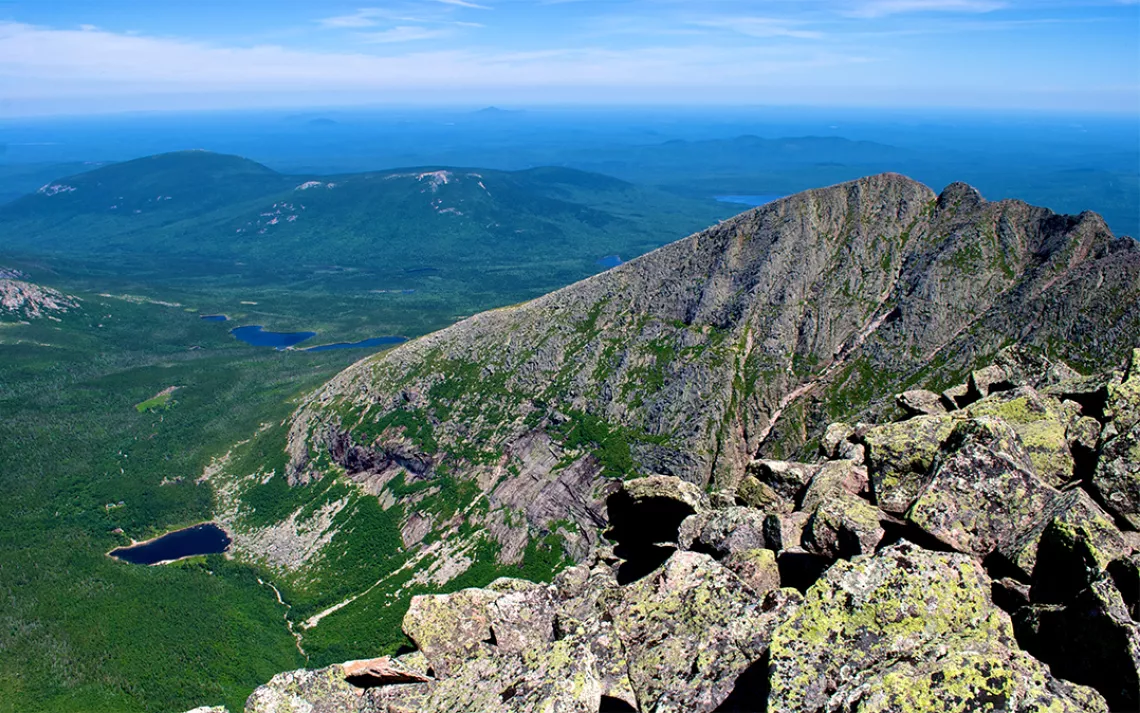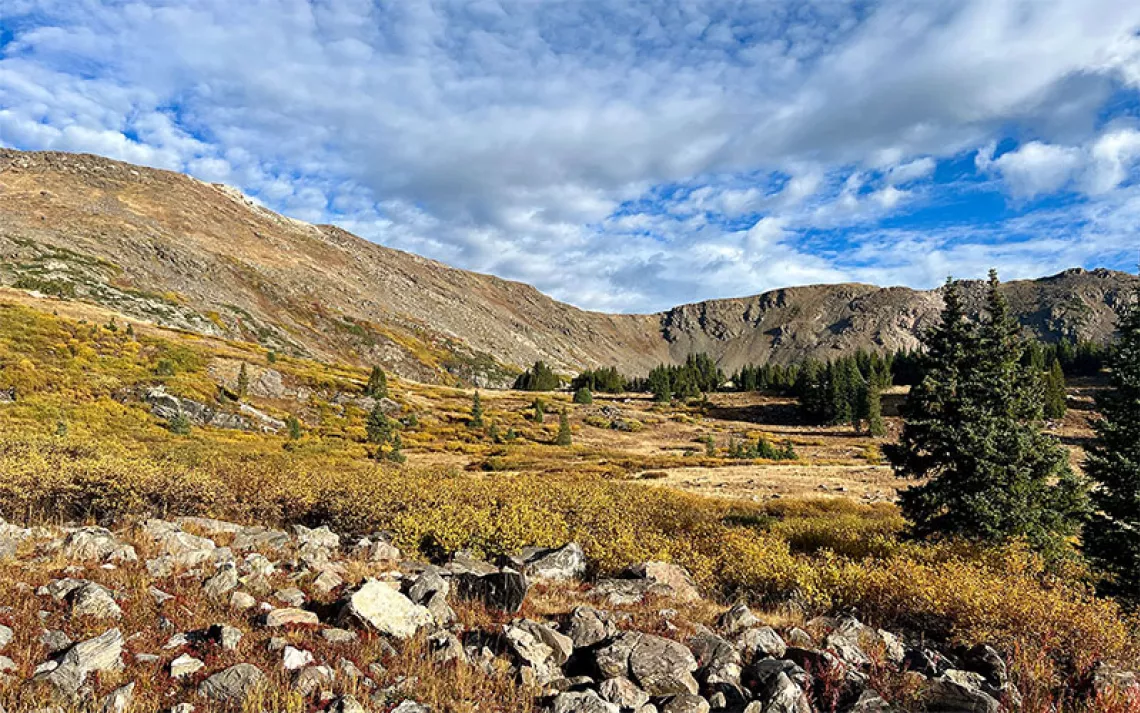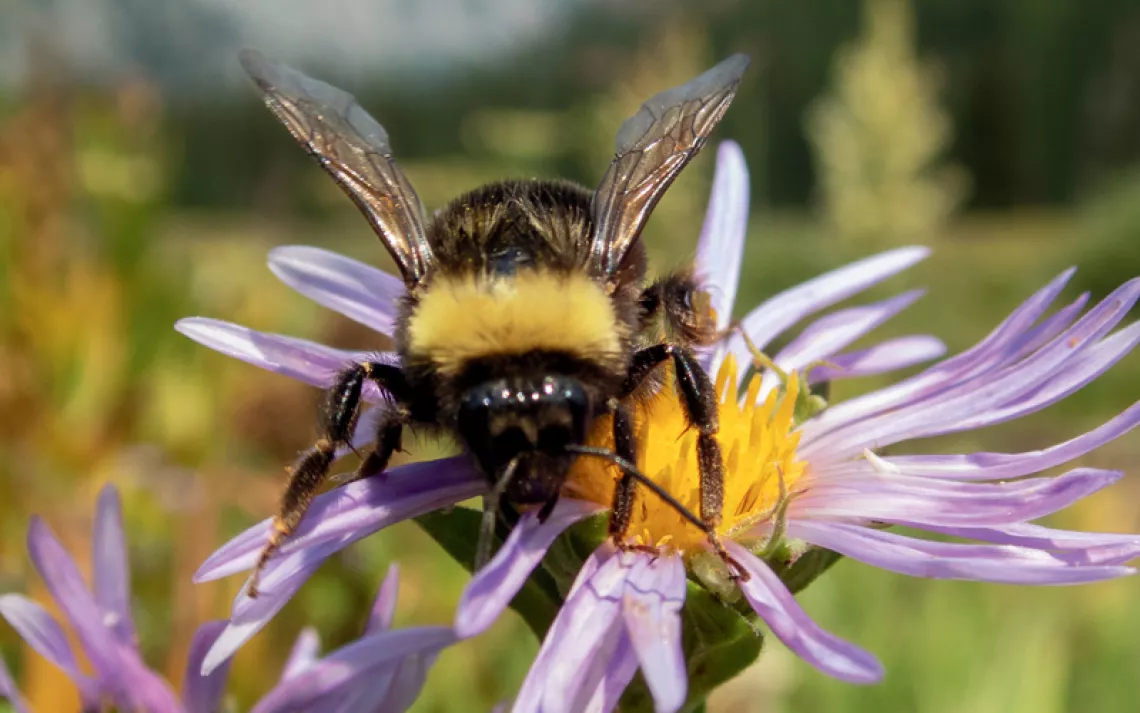When Thoreau Went Nuts on Maine’s Mt. Katahdin

Photo by iStockphoto/Univers101
Robert Moor’s debut book, On Trails, should be read by anyone who has spent time following a footpath through the woods. On Trails trips through natural history, anthropology, gonzo reporter’s adventures, and memoir in a ramble that unpacks the many meanings of the routes we humans and other animals sketch on the land. “To deftly navigate this world,” he writes near the start of the book, “we will need to understand how we make trails, and how trails make us.”
In this excerpt from Chapter 5, Moor recounts Henry David Thoreau’s now-famous ascent of Maine’s Mt. Katahdin—and Thoreau’s near-meltdown on coming into contact with the raw earth—and then launches into a meditation on wilderness.
—Jason Mark
♦
In 1846, Henry David Thoreau made a failed bid to climb Mt. Katahdin, the highest peak in the state of Maine. He and two companions made their way to its base by canoe, guided by an old Indian man named Louis Neptune, who advised Thoreau to leave a bottle of rum on top of the mountain to appease the mountain spirit. On their climb, Thoreau and his companions followed moose trails and scrambled cross-country. In one harrowing instance, while crawling over the flattened tops of the black spruce trees that had grown up between the mountain’s massive boulders, Thoreau looked down to find that below him, in the crevices, lay the sleeping forms of bears. (“Certainly the most treacherous and porous country I ever traveled,” he wryly observed.)
The party became lost in fog and never made the summit. But on his descent, passing through an area called the Burnt Lands, Thoreau—who had spent almost his entire life in bucolic Concord, where a surplus of farms and fences had rendered the landscape “tame and cheap”—suddenly realized he had stumbled upon a wholly wild place. He found the Burnt Lands savage, awful, and unspeakably beautiful. Here, he sensed, was the universal bedrock underlying the artifices of humankind. Recalling the experience, he wrote:
This was that Earth of which we have heard, made out of Chaos and Old Night. Here was no man's garden, but the unhandseled globe. It was not lawn, nor pasture, nor mead, nor woodland, nor lea, nor arable, nor wasteland…Man was not to be associated with it. It was Matter, vast, terrific…rocks, trees, wind on our cheeks! the solid earth! the actual world! the common sense! Contact! Contact!
How, one must wonder, had a human being—indeed, a whole generation of human beings—become so abstracted from the land (the solid earth! the actual world!) as to warrant such an epiphany? The answer stretches back through our ancestral past: through agriculture, which obviated the hunter-gatherer’s need to walk, study, and interact with whole ecosystems; through writing, which replaced the landscape as an archive of communal knowledge; through monotheism, which vanquished the animist spirits and erased their earthly shrines; through urbanization, which concentrated people in built environments; and through a snug pairing of mechanical technology and animal husbandry, which allowed people to travel over the earth at blurring speeds. Euro-Americans had been working for millennia to forget what an unpeopled planet looked like. To see it afresh came as a shock.
In the centuries following Thoreau’s revelation, a steady trickle of hikers flowed toward Katahdin in search of the same ineffable experience. It gained a reputation as the antithesis to peaks like New Hampshire's Mt. Washington, where, according to one account, “large flocks of hitherto ‘un-mountain-fähig', both male and female, streamed up the mountains like a transplanted tea party.” But despite its growing popularity, the mountain resisted all attempts to tame it. During the height of the summit house craze of the 1850s, Maine politicians, envious of the commercial successes of Mount Washington, chartered a road to be built over Katahdin. A crew was sent out to survey a path, but they returned with a route so absurdly steep that no carriage could climb it, and the project was soon abandoned. Even into the 1890s, while trail-builders on Mount Washington were rearranging boulders to construct paths so smooth they reportedly could be walked blindfolded, the paths on Katahdin remained, in the Watermans’ words, “but the roughest of cuts through the north woods.”
The longer Katahdin resisted attempts to tame it, the Watermans wrote, the more it attracted “pilgrims” who enjoyed its wild character—and who, moreover, would fight to keep it that way. In 1920, an eccentric millionaire named Percival Baxter climbed Katahdin via the vertiginous Knife’s Edge route. Greatly impressed, he vowed to ensure that the land would remain “forever wild.” The following year, as governor of the state, he fought to have the area recognized as a state park. When the state legislature refused, he began buying the land with his own fortune, eventually acquiring two hundred thousand acres, which was later designated as a state park. From the outset, Baxter insisted that “Everything in connection with the Park must be left simple and natural and must remain as nearly as possible as it was when only the Indians and the animals roamed at will through these areas.”
Ten years later, there was a push by Baxter’s political nemesis, Owen Brewster, to make the area look more like the White Mountains, by building new motor roads (now feasible, thanks to technological advances) along with a large lodge and a series of smaller cabins. Baxter successfully fought them back, and the park remained stubbornly inaccessible. The park’s wildness, in other words, was not given. It was made.
It may sound strange (even sacrilegious) to some, but in a very real way, wilderness is a human creation. We create it in the same sense that we create trails; we do not create the soil or the plants, the geology or the topology (although we can, and do, shift these things). Instead, we delineate the place, by defining its boundaries, its meaning, and its use. The history of Katahdin is emblematic of the wilderness as a whole, which has always been the direct result of human ingenuity, foresight, and restraint.
“Civilization,” wrote the historian Roderick Nash, “invented wilderness.” According to his account, the wilderness was born at the dawn of agro-pastoralism, when we began cleaving the world into the binary categories of wild and tame, natural and cultivated. Words for wilderness are notably absent among the languages of hunter-gatherer peoples. (“Only to the white man,” wrote Luther Standing Bear, “was nature a wilderness.”) From the vantage point of a farmer, the wilderness was a strange, barren land, full of poisonous plants and deadly animals, antithetical to the warmth and security of home. To these land-tamers, wilderness became synonymous with confusion, wickedness, and suffering. William Bradford, the governor of the Plymouth Colony, was representative of this mindset when he deemed the uncolonized countryside “a hideous and desolate wilderness full of wild beasts and wild men.”
For centuries after the rise of agriculture, we erected fences to keep our cultivated land safe from whatever lurked in the darkness. But the realm of cultivation continued to spread, insatiably, until it at last began to endanger the wilderness, rather than the other way around. Then we began fencing in the wild, to keep it safe from us. For obvious reasons, this shift came much earlier on the isle of Britain—which began walling off its forests a thousand years ago—than it did on the seemingly endless American continent.
Amid in the coal-fired fug of industrialism, people began to recognize that the unchecked spread of civilization could be toxic, and the wilderness, by comparison, came to represent cleanliness and health. Quite suddenly, the symbolic polarity of the word “wilderness” was reversed: it went from being wicked to being holy. That switch allowed a new set of moral attitudes toward the non-human world to take hold. Even a man as wilderness-averse as Aldous Huxley came to understand that “a man misses something by not establishing a participative and living relationship with the non-human world of animals and plants, landscapes and stars and seasons. By failing to be, vicariously, the not-self, he fails to be completely himself.”
This is the most succinct definition of the wilderness I have found: the not-self. There, in the one place we have not re-molded in our own image, a very deep and ancient form of wisdom can be found. “At the heart of all beauty lies something inhuman,” wrote Albert Camus. We glimpse this inhuman heart only once the rosy lens of familiarity has fallen away. Then, Camus wrote, we realize that the world is “foreign and irreducible to us”—a sensation acutely familiar to both Thoreau and Huxley. “These hills, the softness of the sky, the outline of these trees at this very minute lose the illusory meaning with which we had clothed them,” he wrote. “The primitive hostility of the world rises up to face us across millennia.” We over-civilized humans cherish wilderness because it both fosters and embodies that sense of not-self—it is a brazenly naked land, where a person, in mingled fear and awe, verging on nonsense, can cry out: Contact!
Reprinted with permission from Simon and Schuster.
 The Magazine of The Sierra Club
The Magazine of The Sierra Club






